Social Selling Tips: How to Build Relationships That Convert in 2025/26
By Social-Hire.com
Are you tired of cold calling prospects who hang up on you? Or sending LinkedIn messages that get ignored? You're not alone. Traditional sales methods feel increasingly outdated, and frankly, they're not delivering the results your business needs. The good news? There's a better way to connect with prospects and build the relationships that actually convert into revenue.
Social selling isn't just about posting content and hoping for the best—it's a strategic approach where you use social media platforms to engage directly with prospects, share valuable insights, and build trust over time (Source: Highspot). With 5.24 billion active social media users globally representing nearly 64% of the world's population, the opportunity to reach your ideal clients has never been greater (Source: SocialPilot).

In this guide, we'll walk you through proven social selling strategies that deliver real results. You'll learn how to optimize your profile for credibility, identify the right prospects, create content that converts, and build relationships that translate into meetings and sales.
These aren't theoretical tips—they're battle-tested approaches that work for professional services firms, recruitment agencies, and B2B companies across the UK, US, and Canada.
What Is Social Selling and Why Does It Matter?
Social selling is a methodology where sales professionals use social media platforms to engage directly with prospects, share valuable content, build relationships, and foster trust—instead of relying on traditional cold outreach (Source: Highspot).
It's not about pitching your services in every post or connection request. Instead, it's about becoming a trusted advisor who provides value first and builds relationships that naturally lead to business opportunities.
The numbers don't lie. Businesses leveraging social selling report increased brand awareness, stronger customer relationships, and higher conversion rates compared to those using traditional methods (Source: Tagembed).
The B2B lead generation market is projected to grow from $11.23 billion in 2025 to $29.51 billion by 2034—a trend closely tied to the adoption of advanced social selling strategies (Source: Skrapp).
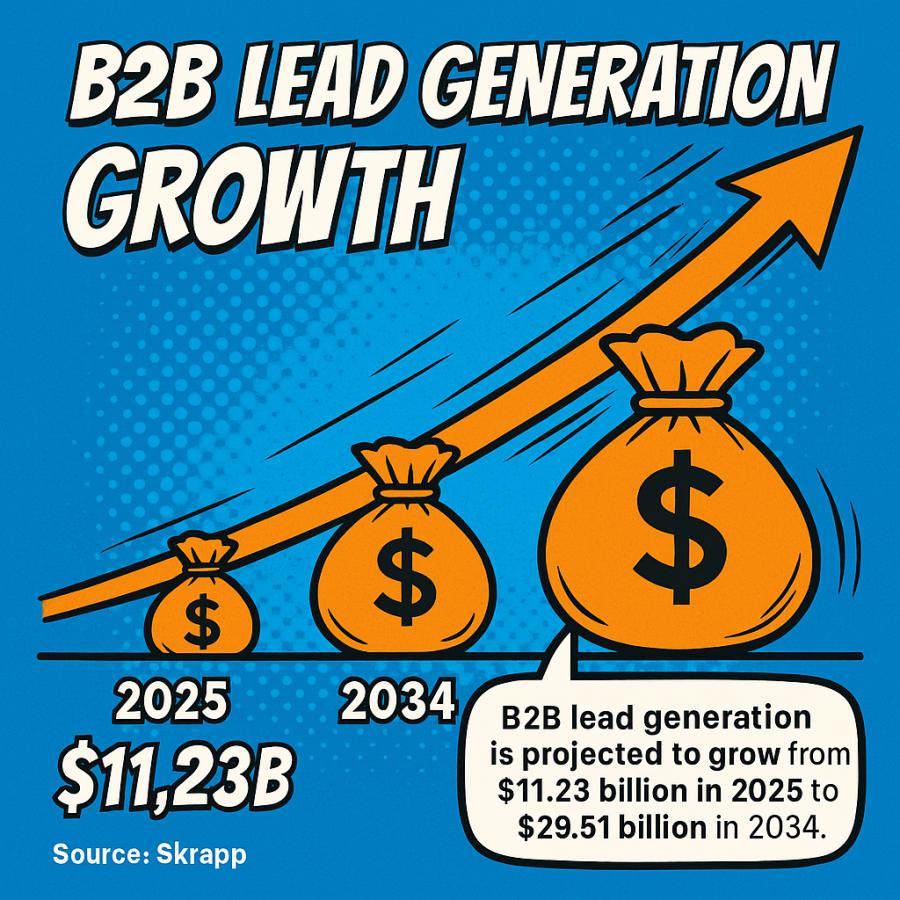
Here's what makes social selling particularly powerful for professional services and B2B firms. The table below shows how social selling compares to traditional sales methods across key metrics:
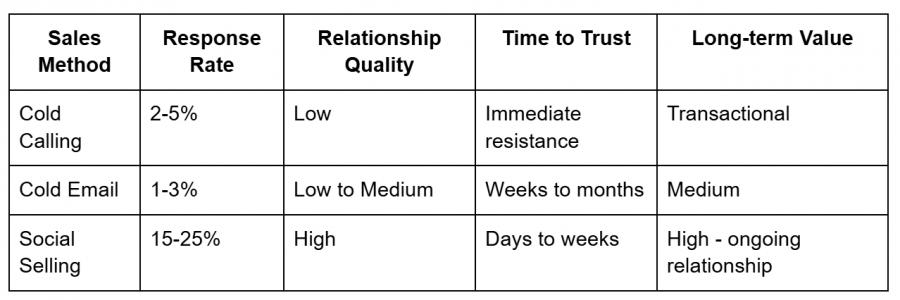
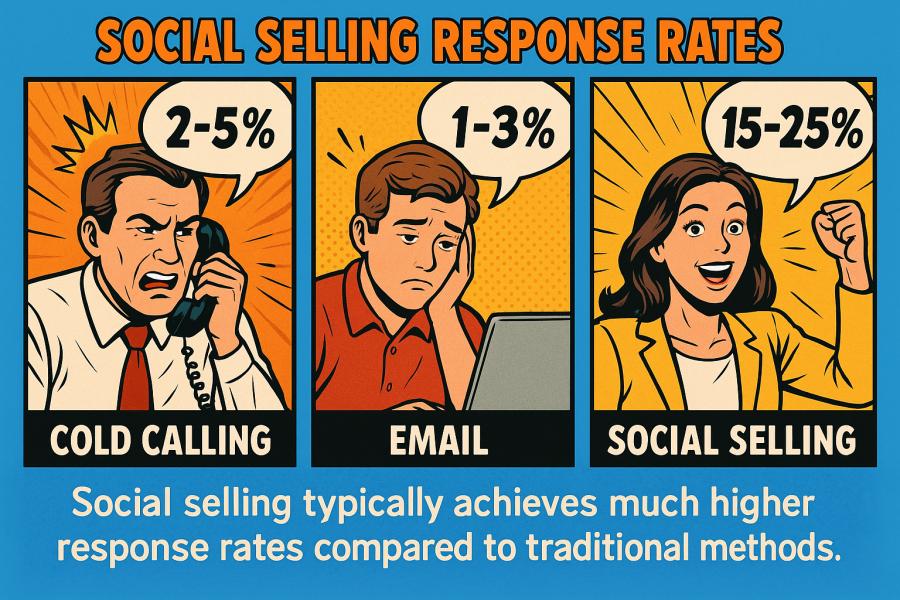
What's driving this shift? Your prospects are already on social media, researching solutions, and looking for trusted advisors. They're reading content, engaging in discussions, and making buying decisions based on what they see online. If you're not part of those conversations, you're missing out on opportunities.
Step 1: Optimize Your Profile for Credibility and Trust
Your social media profile is your digital business card, and first impressions matter. Before you start reaching out to prospects or sharing content, you need a profile that screams credibility and expertise. This isn't about fancy graphics or clever taglines—it's about clearly communicating who you help and what results you deliver.
Complete your professional profile on platforms like LinkedIn; include a clear headline, summary focused on value delivered, relevant experience, and recommendations from clients or colleagues (Source: Skrapp). Your headline should immediately tell visitors what you do and who you help. Skip generic titles like "Sales Manager" and opt for something specific like "Helping recruitment agencies fill senior roles faster through strategic social media."
Your profile summary deserves special attention. This is where you tell your story and connect with prospects' pain points. Start with the problems you solve, share specific results you've achieved for clients, and end with a clear call-to-action. Think of it as a mini case study that builds trust before you even start a conversation. For more detailed guidance on crafting a compelling profile, check out our LinkedIn profile optimization tips for business owners.
The following elements are essential for a high-converting social selling profile:
- Professional headshot that builds trust and approachability
- Headline that clearly states who you help and what outcomes you deliver
- Summary that addresses prospect pain points and showcases credibility
- Experience section with quantified achievements and client results
- Recommendations from satisfied clients that provide social proof
Step 2: Identify and Connect With Your Ideal Prospects
Social selling success starts with connecting with the right people. You could have the most optimized profile and share brilliant content, but if you're not engaging with your ideal prospects, you won't see results. This is where many professionals go wrong—they try to connect with everyone instead of focusing on quality relationships with decision-makers who fit their ideal client profile.
Use platform-specific search tools like LinkedIn's filters to find decision-makers matching your ideal customer profile (Source: Highspot). On LinkedIn, you can filter by job title, company size, industry, location, and even specific companies. The key is being specific about who you want to reach. If you help recruitment agencies, search for "recruitment directors" or "agency owners" rather than just "recruiters."
Once you've identified prospects, resist the urge to immediately pitch your services. Instead, study their profile, recent posts, and company updates. Look for conversation starters—perhaps they've shared an industry challenge you can help with, or their company just announced growth plans that align with your services. This research phase is crucial for building authentic connections.
Here's a strategic framework for prospect identification and engagement that we use with our clients:
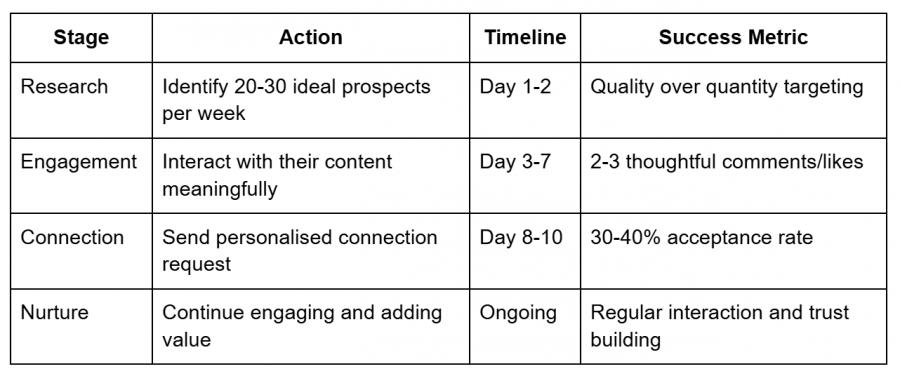
When sending connection requests, personalise every message. Reference something specific from their profile or recent activity. A simple "I noticed you're expanding your team—I help agencies like yours find top talent faster" works infinitely better than the generic "I'd like to add you to my professional network."
For specific messaging strategies that work for professional services firms, our guide on how to message potential clients on LinkedIn provides templates and examples you can adapt for your industry.
Step 3: Create and Share Value-Driven Content
Content is the fuel that powers social selling relationships. But we're not talking about random updates about what you had for lunch or generic motivational quotes. Your content needs to educate, inspire, and solve problems for your ideal prospects. When you consistently share valuable insights, you position yourself as a trusted advisor rather than just another salesperson.
Post regularly about industry trends, case studies, or actionable tips that demonstrate expertise and provide value—not just promotional material (Source: Skrapp). The 80/20 rule works well here: 80% valuable, educational content and 20% promotional content about your services. Your prospects need to see you as someone who understands their challenges and has solutions that work.
The most effective social selling content falls into several categories. Share industry insights that help prospects stay ahead of trends. Post case studies that show how you've solved similar problems for other clients. Create how-to guides that address common challenges in your industry. Ask thought-provoking questions that spark discussions in the comments.
Structure your content around business goals and KPIs rather than random updates, and segment your messaging so each post feels relevant to your target audience (Source: SocialPilot). Our approach to social media strategy focuses on creating content that directly supports your sales objectives rather than just generating likes and shares.
Here are the content types that drive the best results for B2B social selling:
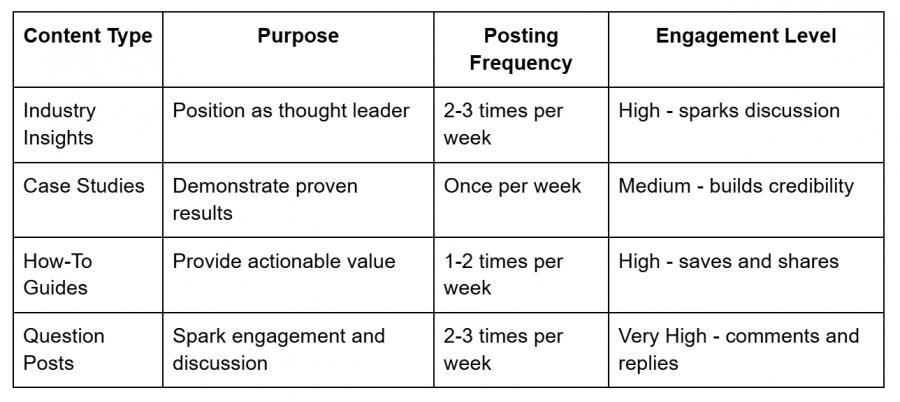
Mix your content formats for maximum reach. Videos perform exceptionally well on platforms like LinkedIn and can help you stand out in busy feeds. Carousel posts allow you to share detailed insights in an easily digestible format. Single-image posts with compelling captions often generate strong engagement. Don't forget about LinkedIn's native polling feature—polls drive significant engagement and provide valuable insights into your audience's preferences.
To maximize your content's impact, consider incorporating user-generated content and testimonials from real customers into your feed—this builds credibility quickly among new prospects who see authentic proof points from their peers (Source: Tagembed). When clients share positive feedback or results, ask permission to share their success stories. These authentic testimonials often perform better than any promotional content you could create.
Step 4: Engage Authentically to Build Relationships
Creating great content is only half the equation. The magic happens when you actively engage with your prospects' content and participate in meaningful conversations. This isn't about dropping promotional comments or generic responses—it's about adding genuine value to discussions and building real relationships over time.
Comment thoughtfully on posts from prospects or industry leaders; ask questions that spark discussion rather than pitching immediately (Source: Highspot). When you see a prospect sharing insights about industry challenges, contribute your own perspective or ask a follow-up question that shows you understand their business. These interactions are far more valuable than a dozen connection requests.
The best social sellers understand that engagement is a two-way street. When someone comments on your content, respond promptly and meaningfully. Thank them for their insights, ask follow-up questions, or share additional resources that might help. These small interactions compound over time and create the foundation for business relationships.
Focus on nurturing connections through personalized messages and ongoing engagement instead of one-off interactions aimed at quick wins (Source: Tagembed). The most successful social sellers we work with treat relationship-building like a marathon, not a sprint. They understand that trust develops over weeks and months of consistent, valuable interactions.
Here's our proven engagement strategy that turns connections into conversations and conversations into clients:
- Set aside 20-30 minutes daily for engagement activities across your key platforms
- Prioritize engaging with prospects' content over posting your own content
- Leave meaningful comments that add value rather than generic praise
- Share relevant content from others in your network to build reciprocal relationships
- Send follow-up messages when appropriate, referencing specific conversations or insights
One particularly effective engagement tactic is using LinkedIn's polling feature to generate discussions. LinkedIn polls can drive significant engagement and client inquiries when used strategically to address industry challenges or trends that matter to your prospects.
Platform-Specific Social Selling Strategies
While the fundamentals of social selling remain consistent, each platform has its own culture, features, and best practices. Success requires adapting your approach to match how your prospects behave on each platform. What works on LinkedIn might fall flat on Twitter, and Instagram requires a completely different content strategy than Facebook.
LinkedIn remains the gold standard for B2B social selling, particularly for professional services firms. The platform's professional focus and robust search capabilities make it ideal for identifying decision-makers and building business relationships.
Sales reps with high LinkedIn Social Selling Index (SSI) scores generate more opportunities and reach quotas more consistently; they also receive promotions an average of 17 months faster than peers with lower SSI scores (Source: Skrapp).
Your LinkedIn strategy should focus on optimizing your SSI score by completing your profile, connecting strategically, posting thought leadership content regularly, and engaging meaningfully in comments and discussions (Source: Skrapp). The SSI measures four key areas: establishing your professional brand, finding the right people, engaging with insights, and building relationships.
Here's how to approach social selling across the major platforms:

On Twitter/X, share timely insights using relevant hashtags and participate in industry chats (Source: Tagembed). The platform's real-time nature makes it ideal for joining conversations around trending topics in your industry. Use threads to share detailed insights that would be too long for a single tweet.
For Instagram, focus on behind-the-scenes content and team spotlights that humanize your brand (Source: Tagembed). Stories and Reels perform particularly well for showcasing company culture and building personal connections with prospects.
Facebook's strength lies in group participation and local networking (Source: Tagembed). Join industry-specific groups where your prospects gather and contribute valuable insights to group discussions. Be patient with Facebook—relationship building happens slower here, but the connections often run deeper.
Measuring Success: The Metrics That Matter
Social selling success isn't measured by vanity metrics like follower counts or post likes. What matters are the business results: leads generated, meetings booked, and revenue attributed to social selling activities. At Social Hire, we've always believed in measuring success through real business outcomes, not just engagement numbers.
The LinkedIn SSI provides a useful benchmark for your social selling effectiveness. Monitor metrics such as the LinkedIn SSI score—which measures four pillars: establishing a professional brand, finding the right people, engaging with insights/content sharing consistency, and building relationships—to benchmark progress against peers and industry standards over time (Source: Skrapp). Your SSI score updates in real-time and provides specific recommendations for improvement.
Beyond platform-specific metrics, track the business impact of your social selling efforts. Monitor how many prospects you connect with each month, what percentage respond to your outreach, and how many convert to meetings or sales calls. These metrics tell you whether your social selling strategy is actually working for your business.
Here are the key performance indicators that successful social sellers monitor:
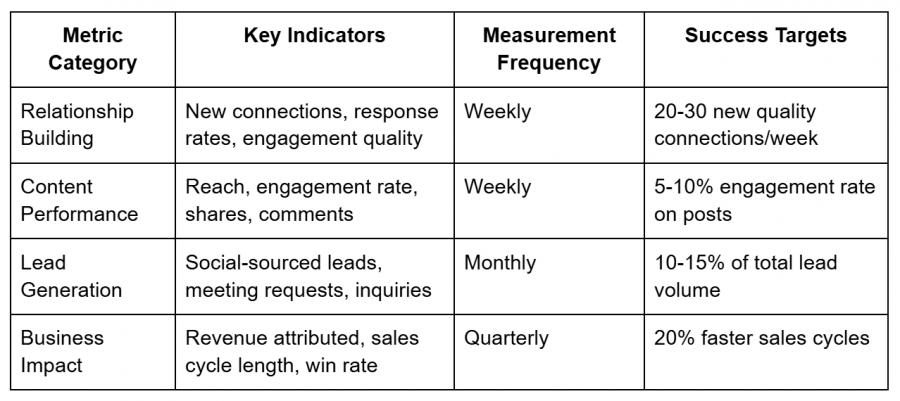
Use the analytics tools provided by each platform to refine your targeting and messaging based on what resonates most with your audience. LinkedIn's analytics show which content performs best with different audience segments. Twitter Analytics reveals which hashtags and posting times drive the most engagement. Instagram Insights help you understand which content formats work best for your followers.
For a complete approach to measuring and optimizing your social selling results, explore our guide to generating leads on social media, which includes specific metrics and benchmarks for different industries.
Advanced Social Selling Techniques for Maximum Impact
Once you've mastered the basics of social selling, there are advanced strategies that can significantly amplify your results. These techniques separate the top performers from those who struggle to see meaningful returns from their social selling efforts. They require more effort and sophistication, but the payoff can be substantial for your business.
Personalize every interaction based on prospect research before reaching out, and respond promptly when leads engage with your content or posts (Source: Tagembed). The most successful social sellers we work with spend significant time researching prospects before making contact. They know the prospect's company challenges, recent achievements, and current priorities.
Video content represents a massive opportunity for social sellers. Personal video messages have response rates 10x higher than text-based outreach. Use tools like Loom or Vidyard to create personalized video messages that reference specific details about the prospect's business or recent posts.
Social listening takes your efforts to the next level. Use tools like Hootsuite or Sprout Social to monitor mentions of your company, competitors, and industry keywords. When prospects mention challenges you can solve, you're positioned to provide timely, relevant solutions.
Advanced social selling also involves strategic content collaboration. Partner with clients to create case study content, co-author industry insights, or participate in joint webinars. These collaborations expand your reach while providing social proof of your expertise.
Here are proven advanced techniques that accelerate social selling results:
- Create prospect-specific video messages that reference their recent posts or company news
- Develop strategic partnerships with complementary service providers for cross-referrals
- Host virtual events or webinars that attract your ideal prospects to your network
- Use social listening tools to identify prospects actively discussing relevant challenges
- Leverage employee advocacy by training your team to amplify your social selling efforts
Avoiding Common Social Selling Mistakes
Even experienced professionals make critical errors that undermine their social selling success. We've seen talented business leaders struggle with social selling because they fall into predictable traps. Understanding these common mistakes helps you avoid them and accelerate your path to success.
The biggest mistake is leading with a sales pitch instead of value. Your prospects' feeds are flooded with promotional content and sales messages. When you immediately pitch your services after connecting, you blend into the noise instead of standing out as someone worth knowing. Start every relationship by giving value, not asking for something.

Another common error is inconsistent activity. Social selling requires regular, sustained effort. Posting sporadically or disappearing for weeks kills momentum and makes it impossible to build meaningful relationships. Your prospects need to see you consistently providing value over time.
Many professionals also make the mistake of focusing on quantity over quality. They try to connect with hundreds of people instead of building genuine relationships with dozens of ideal prospects. It's better to have 50 engaged, qualified connections than 500 passive followers who never interact with your content.
Here are the social selling mistakes that sabotage results and how to avoid them:
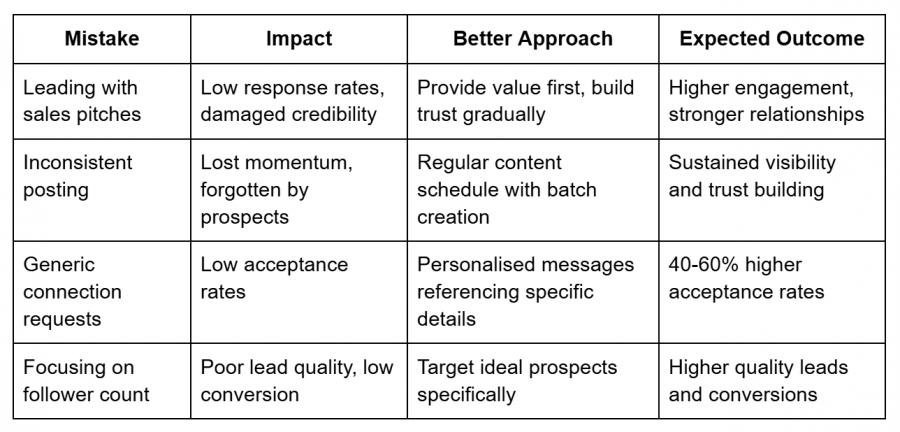
Don't try to be everywhere at once. It's better to excel on one or two platforms than to spread yourself thin across every social network. Choose platforms where your prospects are most active and engaged, then focus your efforts there.
For additional guidance on implementing social selling effectively for your specific business type, check out our collection of social selling tools, tactics and best practices that includes industry-specific tips and proven frameworks.
Building a Sustainable Social Selling System
Social selling success isn't about working harder—it's about working smarter with systems that scale. The most successful social sellers have processes, tools, and habits that make relationship building systematic rather than random. They don't rely on inspiration or motivation; they have frameworks that produce consistent results.
Start by developing content themes that align with your prospects' interests and challenges. Instead of struggling to come up with new post ideas daily, create content pillars that you can revisit regularly. For professional services firms, these might include industry trends, client success stories, team expertise spotlights, and practical tips.
Use scheduling tools like Buffer or Hootsuite to maintain consistent posting schedules without being chained to your phone. Batch content creation allows you to write multiple posts in single sessions, then schedule them throughout the week. This approach ensures consistency while freeing up time for relationship building.
Create templates for common social selling activities. Develop frameworks for connection requests, follow-up messages, and content responses. Templates save time while ensuring your communications remain personalized and professional. Just make sure to customize each message with specific details about the recipient.
Track your activities and results systematically. Use CRM systems like Salesforce or HubSpot to monitor your social selling pipeline. Record which platforms generate the best results, what content types drive the most engagement, and which prospects are moving toward sales conversations.
To understand how social selling fits into a broader lead generation strategy, explore our complete guide to social media for lead generation, which shows how relationship building and lead generation work together to drive sustainable business growth.
Making Social Selling Work for Your Business
Social selling isn't magic, but it is transformational when implemented strategically. The businesses we work with that embrace social selling see dramatic improvements in their lead quality, sales cycle length, and client relationships. They build sustainable growth systems that don't rely on expensive advertising or aggressive cold outreach.
The key is treating social selling as a long-term strategy, not a short-term tactic. Results compound over time as you build larger networks, establish stronger thought leadership, and develop deeper relationships with ideal prospects. The connections you make today become the pipeline opportunities of next quarter.
Start with the platform where your prospects are most active—usually LinkedIn for B2B companies. Focus on profile optimization, strategic connecting, and consistent value-driven content. As you build momentum and see results, you can expand to additional platforms and more sophisticated strategies.
Social selling works particularly well for professional services firms, recruitment agencies, and B2B technology companies because these businesses rely on trust and expertise to win clients. When prospects can see your knowledge and approach before they ever speak with you, the sales conversation starts from a position of credibility rather than skepticism.
For small businesses implementing social selling strategies, our guide on key social selling takeaways for small businesses provides specific tactics tailored to resource constraints and growth objectives.
The most important step is starting. Social selling rewards consistency and persistence more than perfection. Your first posts don't need to go viral, your initial connections don't need to convert immediately, and your early efforts don't need to generate massive results. What matters is building the habits and systems that will drive results over time.
Ready to transform your approach to business development? Social selling offers a path to sustainable growth that doesn't depend on cold calling, expensive advertising, or aggressive sales tactics. It's about becoming the trusted advisor your prospects want to work with before they're ready to buy.
At Social Hire, we help professional services firms, recruitment agencies, and B2B companies implement social selling strategies that generate real business results. Our proven four-step process—audience, strategy, content, conversion—has helped clients across the UK, US, and Canada build stronger pipelines and shorter sales cycles through strategic social media.
If you're ready to see how social selling can work for your business, book a discovery call to discuss your goals and challenges. We'll show you exactly how to turn social media connections into business conversations and sales opportunities.
The kind of stuff that Social Hire do...
We won't just do social media strategies. Social Hire will work collaboratively with your team to ensure your business gets genuine value from us and that your team gets the most out of the service. Our experienced social media managers are motivated to make a enhancements to your social media marketing and reaching targets in a way that realistically makes a difference to your business goals.
Do you have a desire to increase the engagement of your business by utilising digital marketing, but can't work out how to begin?
We're an organisation that helps our clients boost their social media marketing by offering social media marketing on a monthly basis.
You might like these blog posts Small Businesses: Don’t Fear the Gig Economy, 5 Ways How Content Marketing Drives Results for Small Businesses, 5 Reasons to Outsource Social Media Marketing to Someone Else, and How to Prevent a Social Media Crisis.
